Comentarios / Preguntas (195)
![]() Hanne escribió:
Hanne escribió:
Ikke helt sikker på hvordan i forkortet, men i opskrifter står der ( Inkl 6 stoplm til forkandt og 1 kantm) nu ville jeg så gerne vide hvad Inkl står for?
01.11.2022 - 19:09DROPS Design respondió:
Hej Hanne, nu kan vi ikke finde hvor du læser, men inkl 6 stolpm betyder inklusiv de 6 kanmasker til forkant og 1 kantmaske i siden :)
02.11.2022 - 14:27
![]() Anne Marieke escribió:
Anne Marieke escribió:
Hello. Can I suggest that a remark is added for the left front part, to start pattern M1 reversed too, because I have also ended up with the same 'pattern' next to each other and I need to go back and add two stitches to the 14 increases for the neck. Thank you.
08.09.2022 - 11:23
![]() Nancy escribió:
Nancy escribió:
Het ligt misschien aan mij en misschien zoek ik het wel te moeilijk maar ik begrijp het telpatroon M 1 niet. Het vestje is gebreid in een gerstekorrel. Dit is 1 recht, 1 averecht en de volgende nld afwisselend recht boven averecht en averecht boven recht en zo verder. Maar hoe moet ik het telpatroon M 1 zien? 2 recht, 2 averecht en dan de volgende nld afwisselend recht boven averecht enz? Ik hoop op een simpele uitleg.
28.08.2022 - 13:59
![]() Marieke Bergefurt escribió:
Marieke Bergefurt escribió:
Hallo, Ik heb inmiddels het gehele vestje gebreid en ben bij de zakrand aangekomen. Ik begin aan de goede kant met 1 kantsteek in ribbel, daarna 2r/2av en eindig met 2r en 1 kantsteek in ribbel. Wanneer ik dit doe, valt de zakrand niet gelijk met het patroon hiervoor en ook niet met de boordsteek, hij verspringt. Is dit de bedoeling? Het ziet er een beetje vreemd uit en op de foto bij het patroon, lijkt hij wel gelijk te lopen met de boordsteek en M1. Alvast bedankt.
24.08.2022 - 14:32DROPS Design respondió:
Dag Marieke,
Het zou kunnen dat dit een beetje afwijkt omdat je misschien een andere maat breit dan op de foto. Mocht het verspringen, dan kun je ook kijken of je 2 rechts/ 2averechts omdraait als dat mooier uitkomt.
31.08.2022 - 13:57
![]() Emily escribió:
Emily escribió:
I am working on the left side of the piece. I worked the two garter rows before the v-neck increases but it does not seem to have the same effect as it did on the right side piece. Is there a change to this technique on the left side, or any other advice so that my v-neck looks equally beautiful on both sides? Thank you.
04.08.2022 - 00:31DROPS Design respondió:
Dear Emily, the only difference with right front piece is that the short rows will start on left front piece from WS instead of from RS, but then it should be the same (2 extra rows over the front band sts). Hope it can help. Happy knitting!
04.08.2022 - 08:20
![]() Julie escribió:
Julie escribió:
Hi there, I just have a question about the left side. As it’s the reverse of the right I begin the row with 1 garter and finish with 6, but which row of the pattern do I begin with?? as if I start with 1 the band will appear longer than the right side …?
08.07.2022 - 11:37DROPS Design respondió:
Dear Julie, work the pattern as in the right side (start from the same row). Happy knitting!
09.07.2022 - 19:09
![]() Julie escribió:
Julie escribió:
Hi there, I just have a question about the left side. As it’s the reverse of the right I begin the row with 1 garter and finish with 6, but which row of the pattern do I begin with?? as if I start with 1 the band will appear longer than the right side …?
08.07.2022 - 11:36DROPS Design respondió:
Dear Julie, please see answer above.
09.07.2022 - 19:09
![]() Anna Marie Fedel escribió:
Anna Marie Fedel escribió:
Does this little sweater have a cap to match this pattern? Maybe booties? I would love to present a match set?
04.05.2022 - 14:37
![]() Sabine Motti escribió:
Sabine Motti escribió:
Diese Aussage sollte nach meinem Verständnis angepasst werden: \"Wenn alle Zunahmen gestrickt wurden, M1 weiterstricken, mit je 6 M kraus re beidseitig (= 64-72-76 (88-100) M)\", da die Maschenanzahl zu dem Zeitpunkt noch höher ist. Richtig erscheint mir: \"Wenn alle Zunahmen gestrickt wurden, M1 weiterstricken, mit je 6 M kraus re beidseitig. Nachdem alle Abnahmen gestrickt wurden ist die Maschenanzahl 64-72-76 (88-100).\"
03.05.2022 - 17:36DROPS Design respondió:
Die Formulierung wurde angepasst, sodass diese Stelle nicht mehr missverständlich sein sollte. Vielen Dank für den Hinweis! :-)
29.05.2022 - 07:55
![]() Anna Marie Fedel escribió:
Anna Marie Fedel escribió:
When I start the v-neck , I'm confused where to decrease. Before the 6 stitch band or after? Am I eliminating the band at the buttons?
30.04.2022 - 22:54DROPS Design respondió:
Dear Mrs Fedel, when working from the right side, you will decrease at the beginning of the row for the right front piece after the front band stitches, and at the end of the row for the left front piece before the front band stitches (start when 8 sts remain: work 2 sts together and work the 6 front band sts). Happy knitting!
02.05.2022 - 08:40
Checco's Dream#checcosdreamcardigan |
|||||||
 |
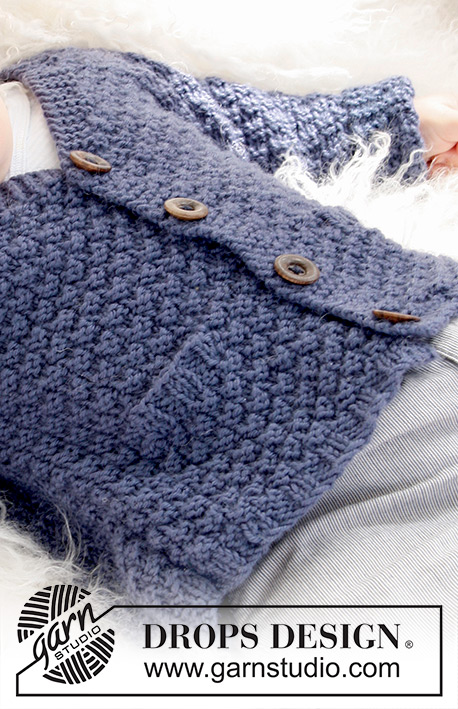 |
||||||
Saco de punto con mangas sin costuras en punto de arroz, para bebé y niños, en DROPS Merino Extra Fine
DROPS Baby 21-11 |
|||||||
|
PT MUSGO (de ida y vuelta en la ag): Todas las vtas de derecho. PATRÓN: Ver diagrama M.1 – el diagrama muestra el patrón por el LD. OJALES: Rem para los ojales en el borde derecho. 1 ojal = tejer juntos de derecho el 3º y 4º pt a partir de la orilla y hacer 1 HEB (lazada). En la vta sig tejer la HEB de derecho. Rem para los ojales cuando la pieza mida: Talla 1/3 meses: 2, 6, 11 y 15 cm. Talla 6/9 meses: 2, 7, 12 y 16 cm. Talla 12/18 meses: 2, 8, 13 y 19 cm. Talla 2 años: 2, 7, 12 y 22 cm. Talla 3/4 años: 2, 8, 13, 19 y 24 cm. TIP PARA DISMINUCIÓN (aplica al cuello-V): Todas las dism son hechas por el LD! DISM DESPUÉS DE 6 PTS DEL BORDE DE LA MANERA SIGUIENTE: Cuando el primer pt debe ser un derecho: Deslizar 1 pt de derecho, 1d, pasar el pt desl por encima. Cuando el primer pt debe ser un revés: Tejer 2 pts juntos retorcidos de revés (es decir, tejer por atrás del pt en vez de adelante). DISM ANTES DE 6 PTS DEL BORDE DE LA MANERA SIGUIENTE: Cuando el último pt debe ser un derecho: Tejer 2 pjd Cuando el último pt debe ser un revés: Tejer 2 pjr ------------------------------------------------------ SACO: Tejido de ida y vuelta en ag circular. Empezar en la pieza del frente, mon pts nuevos para la manga y tejer hasta el hombro. Tejer la otra pieza del frente, después colocar las dos piezas del frente en la ag y tejer hacia abajo en la pieza de la espalda. DELANTERO DERECHO: Mon 31-35-39 (43-43) pts (incl 6 pts del borde en el centro del frente y 1 pt de orillo en el lado) en ag circular tamaño 4 mm con Merino Extra Fine. Tejer 1 vta de revés por el LR. Después tejer la vta sig, de la manera sig, por el LD: 6 pts en PT MUSGO – ver explicación arriba (= borde), * 2d, 2r *, repetir de *a* hasta que reste 1 pt y terminar con 1 pt de orillo en PT MUSGO. Después de un total de 4 vtas en resorte, continuar con el diagrama M.1 con 6 pts del borde en pt musgo en el centro del frente y 1 pt de orillo en pt musgo en el lado. RECUERDE LOS OJALES EN EL BORDE DERECHO – ver explicación arriba. RECUERDE MANTENER LA MISMA TENSIÓN DE TEJIDO DE LA MUESTRA! Cuando la pieza mida 7-8-9 (10-11) cm, tejer la vta sig, de la manera sig, por el LD: 6 pts del borde en pt musgo, diagrama M.1 sobre los 18-22-22 (26-26) pts sig, deslizar los últimos 12-16-16 (20-20) pts que fueron tejidos en un gancho o seguro aux para la orilla del bolsillo, continuar el diagrama M.1 sobre los 6-6-10 (10-10) pts sig y terminar con 1 pt de orillo en pt musgo. En la vta sig mon 12-16-16 (20-20) pts nuevos sobre los pts en el gancho o seguro aux = 31-35-39 (43-43) pts. Tejer el patrón como antes hasta que la pieza mida 16-17-20 (23-25) cm. LEER TODA LA SECCIÓN SIGUIENTE ANTES DE CONTINUAR! CUELLO-V: Tejer 2 vtas en pt musgo, de ida y vuelta, sobre los 6 pts del borde al inicio de la vta (no tejer los otros pts en la vta) – esto se hace para que el cuello-V tenga una apariencia más bonita. Después tejer sobre todos los pts nuevamente, y, AL MISMO TIEMPO, dism para el cuello-V en vtas alternas (es decir, en cada vta por el LD) de la manera sig: Dism 1 pt un total de 12-14-16 (16-16) veces – leer TIP PARA DISMINUCIÓN. AUMENTOS PARA LA MANGA: AL MISMO TIEMPO mon pts nuevos al final de cada vta, en el lado, para la manga: 5 pts 4-4-5 (5-5) veces, 7 pts 0-1-1 (2-3) veces y 25-24-21 (22-27) pts 1 vez. Después del último aum, continuar el diagrama M.1 con 6 pts en pt musgo en cada lado para el borde y la orilla de la manga hasta que la pieza mida 27-29-33 (37-40) cm. Tenemos ahora 64-72-76 (88-100) pts en la ag. Insertar un marcapuntos (MP) aquí – AHORA MEDIR LA PIEZA DESDE AQUÍ. Continuar el patrón como antes hasta haber tejido 1 cm a partir del MP – ajustar para que la última vta sea por el LR. Deslizar los pts en un gancho o seguro aux. DELANTERO IZQUIERDO: Tejer como la pieza del delantero derecho, pero en sentido inverso. También asegurarse de tejer M.1 en sentido opuesto (efecto espejo) en relación a la pieza del delantero derecho. NOTA: No rem para ojales en el borde izquierdo. ESPALDA: Deslizar los 64-72-76 (88-100) pts de la pieza del delantero derecho de regreso en la ag circular tamaño 4 mm, mon 14-14-18 (18-22) pts nuevos en la ag (= línea del escote de la espalda) y deslizar los 64-72-76 (88-100) pts de la pieza del delantero izquierdo en la misma ag circular = 142-158-170 (194-222) pts. Tejer la vta sig, de la manera sig, por el LD: 6 pts en pt musgo (= orilla de la manga), diagrama M.1 como antes sobre los 52-60-64 (76-88) pts sig, 26-26-30 (30-34) pts en pt musgo (= orilla del escote de la espalda), diagrama M.1 sobre los 52-60-64 (76-88) pts sig y 6 pts en pt musgo (= orilla de la manga). Continuar de esta manera hasta haber tejido 2 surcos (= 4 vtas en pt musgo) sobre los 26-26-30 (30-34) pts centrales. Después continuar el diagrama M.1 como antes sobre todos los pts, con 6 pts en pt musgo en cada lado para las orillas de las mangas. Cuando la pieza mida 7½-8-8 (8½-8½) cm a partir del MP en el hombro, rem al inicio de cada vta, en cada lado, de la manera sig: 25-24-21 (22-27) pts 1 vez, 7 pts 0-1-1 (2-3) veces y 5 pts 4-4-5 (5-5) veces = 52-56-64 (72-76) pts restantes en la pieza de la espalda. Continuar el diagrama M.1 con 1 pt de orillo en pt musgo en cada lado hasta que la pieza mida 25-27-31 (35-38) cm a partir del MP. Tejer la vta sig, de la manera sig, por el LD: 1 pt de orillo en pt musgo, * 2d, 2r *, repetir de *a* hasta que resten 3 pts y terminar con 2d y 1 pt de orillo en pt musgo. Después de un total de 4 vtas en resorte, tejer 1 vta de derecho (por el LD) sobre todos los pts antes de rem flojamente. TERMINACIÓN: Hacer las costuras laterales y de la parte de abajo de las mangas a 1 pt del pt de orillo. Coser los botones. Doblar hacia arriba los 5 cm inferiores en cada manga y asegurar, si necesario, con pequeñas puntadas prolijas. ORILLA DEL BOLSILLO: Deslizar los 12-16-16 (20-20) pts del gancho o seguro aux en una de las piezas del frente de regreso en la ag circular tamaño 4 mm. Tejer resorte, de ida y vuelta, con 1 pt en pt musgo y 2 pts derechos en cada lado (visto por el LD). Cuando la abertura del bolsillo mida 2½-2½-3 (3-3) cm, rem flojamente con derecho sobre derecho y revés sobre revés. Coser la orilla del bolsillo a la pieza del frente, con punto malla, en cada lado de la pieza. Coser la abertura del bolsillo a la parte de abajo de la orilla (donde los pts fueron colocados en un gancho o seguro aux) por el revés de la pieza. Tejer otra orilla de bolsillo de la misma manera en la otra pieza del frente. |
|||||||
Explicaciones del diagrama |
|||||||
|
|||||||
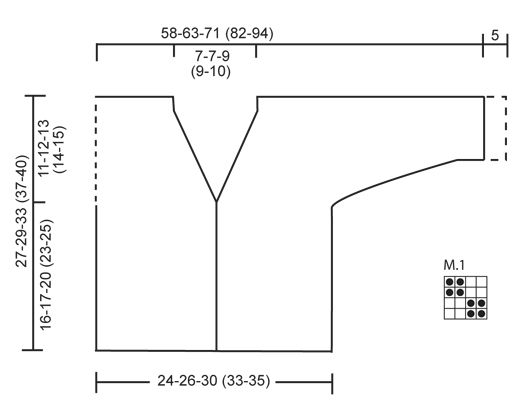 |
|||||||
¿Terminaste este patrón?Entonces, etiqueta tus fotos con #dropspattern #checcosdreamcardigan o envíalas a la galería #dropsfan. ¿Necesitas ayuda con este patrón?Encontrarás 15 videos tutoriales, un espacio para comentarios/preguntas y más visitando la página del patrón en garnstudio.com © 1982-2025 DROPS Design A/S. Todos los derechos reservados. Este documento, incluyendo todas sus sub-secciones, está protegido por los derechos de autor (copyright). Lee más acerca de lo que puedes hacer con nuestros patrones en la parte de abajo de cada patrón de nuestro sitio. |
|||||||








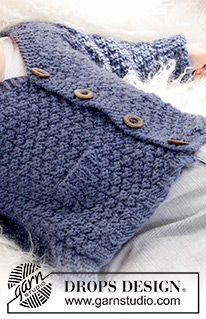

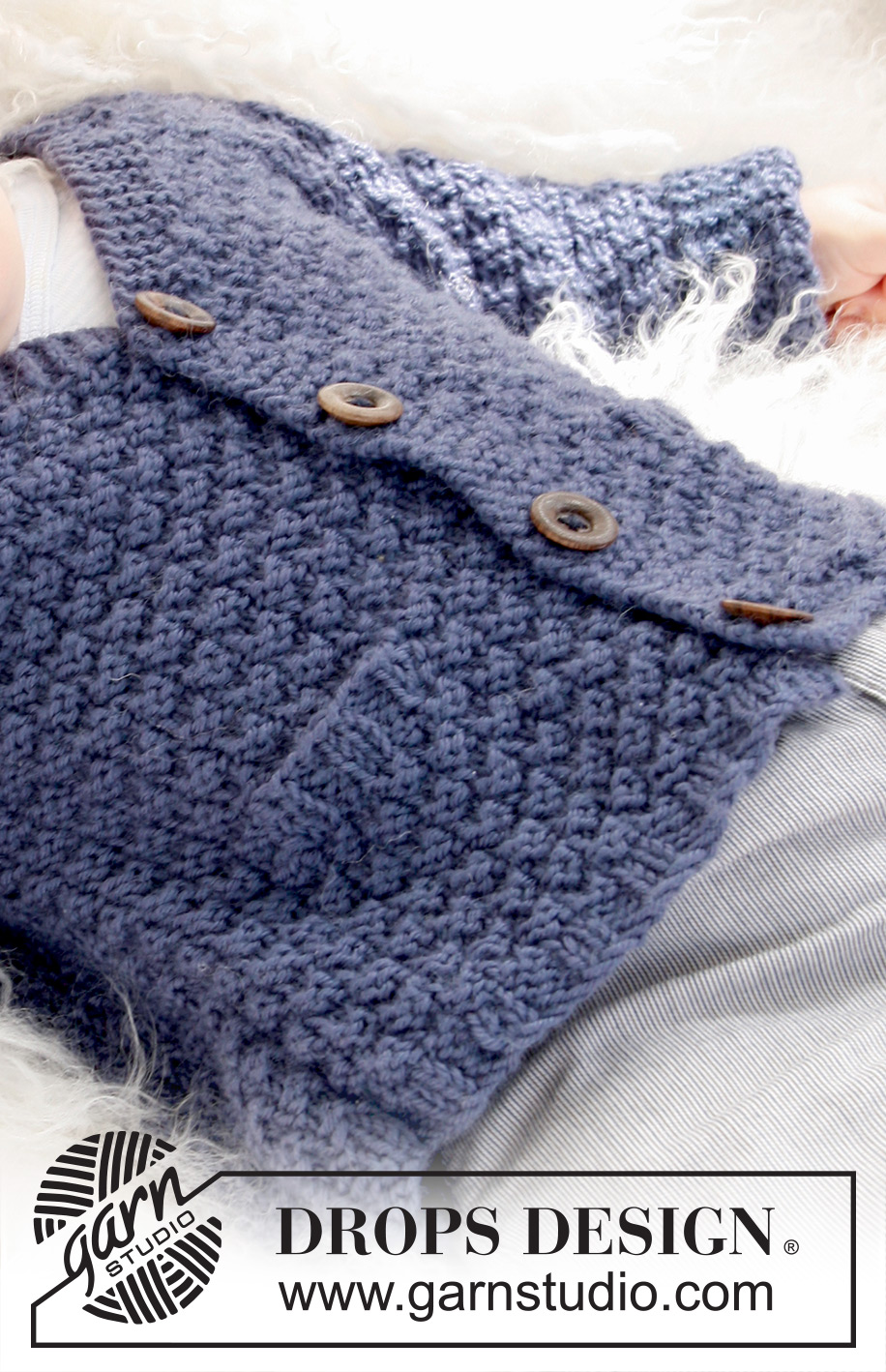

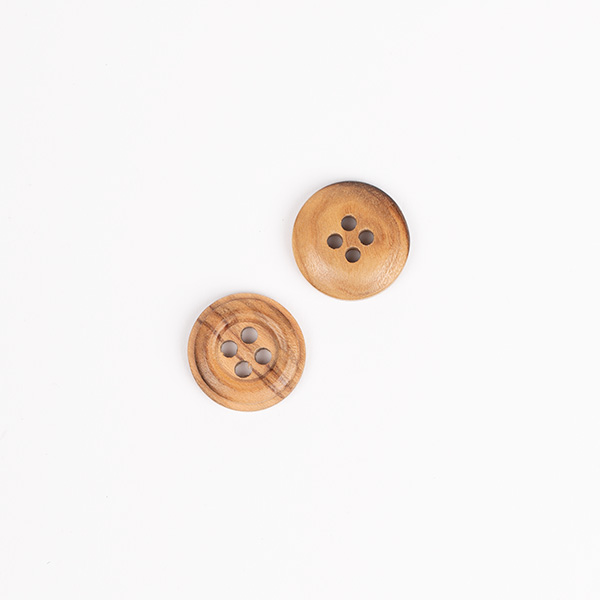

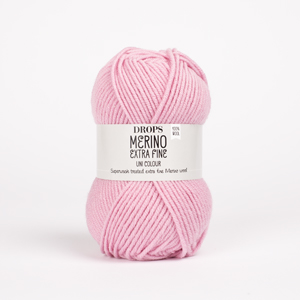
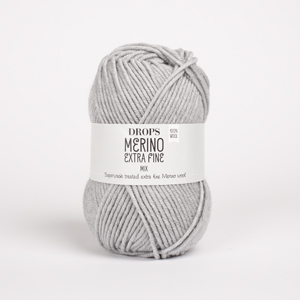






































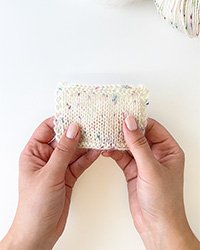

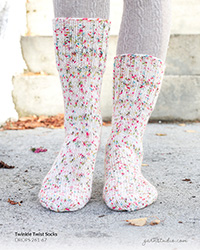
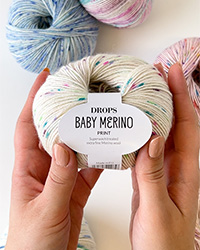
Escribe un comentario sobre DROPS Baby 21-11
¡Nos encantaría saber qué piensas acerca de este patrón!
Si quieres escribir una pregunta referente al patrón, por favor asegúrate de elegir la categoría correcta en el formulario debajo, para acelerar el proceso de respuesta. Los campos obligatorios están marcados con un *.